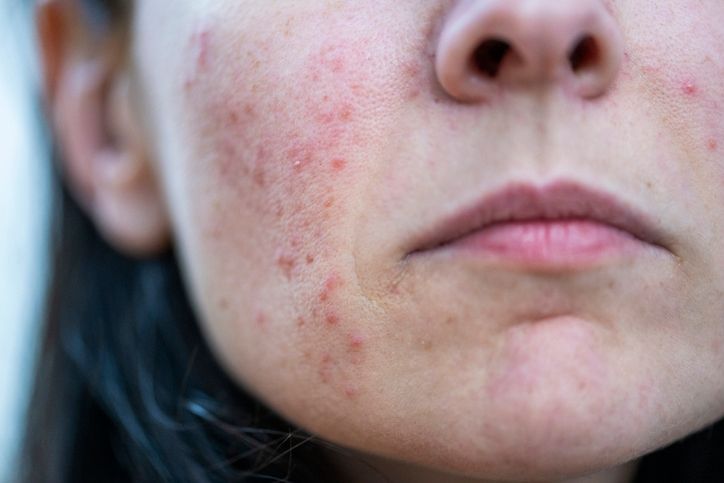Author: Natalie Ng|Updated: 6 May 2025
If your skin keeps breaking out, feels dry in spots, or looks red and irritated, your skin's pH balance might be off. Healthy skin usually sits at a slightly acidic level on the pH scale — between 4.5 and 5.5. This range helps your skin stay strong and able to protect itself. But everyday things like sun exposure, harsh skincare products, over exfoliating, or even your tap water can push your skin out of balance. When that happens, your skin barrier weakens. This can lead to skin concerns like dryness, irritation, clogged pores, and more breakouts. You can bring your skin back into balance by understanding what affects the pH of your skin and making a few simple changes. Choosing a pH balanced cleanser and avoiding high pH ingredients like sodium lauryl sulfate can help restore your skin’s natural pH and support a healthy barrier. Keep reading to learn what causes pH imbalance in skin, how it affects your skin’s protective barrier, and how to get your skin’s pH levels balanced again for stronger, calmer skin.

What Is Skin pH and Why Does It Matter?
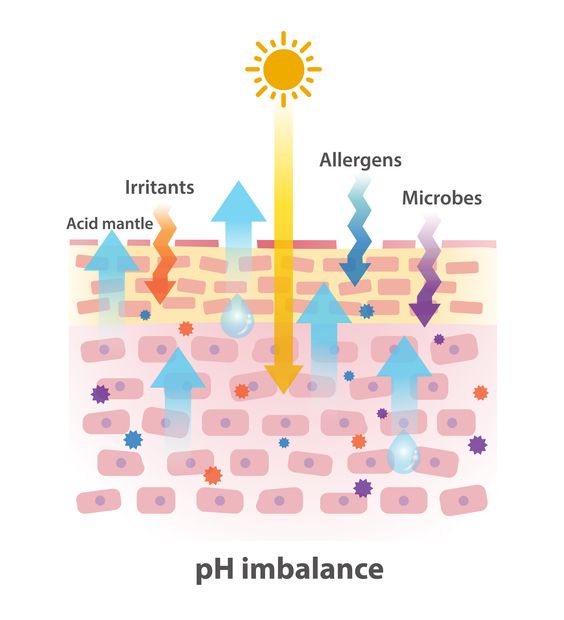
Your Skin’s Surface Is Naturally Slightly Acidic
The skin surface pH tells you how acidic or alkaline your skin is. The pH scale ranges from 0 to 14 — with 7 being neutral. Anything below 7 is acidic, while anything above is alkaline. Healthy skin pH sits between 4.5 and 5.5. This means your skin is slightly acidic by nature.
This slight acidity supports the skin’s acid mantle, a thin layer that helps guard your skin against bacteria, pollution, and external factors like sun exposure or harsh ingredients. It also helps your skin hold on to moisture and keep its natural oils balanced.
Why Your Skin’s pH Balance Matters
When your skin’s pH balance stays in its natural acidic zone, your skin barrier stays strong. This means fewer skin concerns like dryness, sensitivity, or breakouts. But when the pH shifts too far — whether due to alkaline cleansers, over exfoliating, or even tap water — your skin can’t protect itself as well.
You might notice signs like tightness, itching, or patches of dryness. You could also see more clogged pores, or that your skin becomes oily in some places but flaky in others. These are all signs that your skin pH levels are off.
Balanced Skin Starts With Understanding pH
Understanding the pH of your skin makes it easier to pick skincare products that work with your skin, not against it. Using a pH balanced cleanser or avoiding high pH ingredients like sodium lauryl sulfate can help support your skin’s natural pH and improve overall appearance.

Common Signs Your Skin's pH Is Out of Balance

1. Redness, Dryness, and Itching
If your skin’s pH level shifts away from its natural range, it can trigger visible irritation. Redness often shows up around the nose, cheeks, or chin and doesn’t fade easily. Dry patches may feel tight or itchy, even after using a moisturizer. These signs suggest your skin’s barrier is struggling to retain moisture.
2. Sudden Breakouts or Excess Oil
A pH imbalance can change sebum production. Your skin may start producing more oil than usual, leading to clogged pores and breakouts. These breakouts might appear in areas where you don’t normally get them. If your skin feels greasy shortly after cleansing, it may be reacting to a higher pH environment.
3. Unusual Sensitivity to Products
Products that used to feel fine might suddenly sting or burn. This reaction happens when the skin barrier weakens, making your skin more reactive. A disrupted pH level reduces the skin’s ability to handle active ingredients, fragrances, or preservatives found in common skincare products.
4. Flaky Texture and Dull Appearance
When the skin’s natural pH is off, dead skin cells don’t shed properly. This can leave your skin with a rough, uneven texture. Even if you exfoliate regularly, the surface may still look dull. The issue often lies with your skin’s pH, not just product build-up.
5. Both Dry and Oily at the Same Time
Some people experience combination symptoms — dry flakes on the cheeks, but oil and breakouts on the forehead or chin. This mixed signal is a strong indicator that your skin's pH levels are out of sync. It suggests your skin is trying to compensate in different ways across the face.
6. Poor Product Absorption
A disrupted pH affects how well skincare products absorb. If your skin seems to reject even lightweight products or feels coated instead of hydrated, your pH balance may be affecting the skin barrier’s function. This makes it harder for useful ingredients to penetrate the skin surface.
Read More
Book Now to Experience
Acne Treatment
1 Minute Self-Registration
Date should not be before minimal date

Why Is pH-Level Related To Skin Problems

1. Healthy Skin Requires a Slightly Acidic pH
Your skin naturally maintains a slightly acidic pH, usually between 4.5 and 5.5. This range supports the skin’s acid mantle — a thin, protective layer made of natural oils, sweat, and dead skin cells. This layer keeps moisture in and blocks harmful bacteria from entering.
When the pH of your skin stays within this range, your skin barrier stays strong, your natural oils remain balanced, and your skin is better at protecting itself against irritation and infection.
2. Disruption Affects the Skin’s Barrier Function
When your skin’s pH shifts too far in either direction — too acidic or too alkaline — the skin’s protective barrier starts to break down. This makes it harder for your skin to retain moisture and defend itself against external factors like pollution, sun exposure, and bacteria.
As a result, your skin might feel dry, oily, or both. You might also notice more acne, increased redness, or irritation, even from products that used to work fine.
3. Alkaline pH Can Trigger Skin Conditions
Alkaline cleansers and harsh skincare ingredients like sodium lauryl sulfate can push the skin’s pH above 5.5. This weakens the skin’s natural defenses. It can also disrupt the microbiome — the layer of good bacteria on the skin that supports healthy skin function.
This type of disruption is linked to skin concerns like acne, eczema, and sensitivity. If your skin often reacts badly to products, it could be a sign that your pH balance has been affected.

Understanding Skin pH Levels
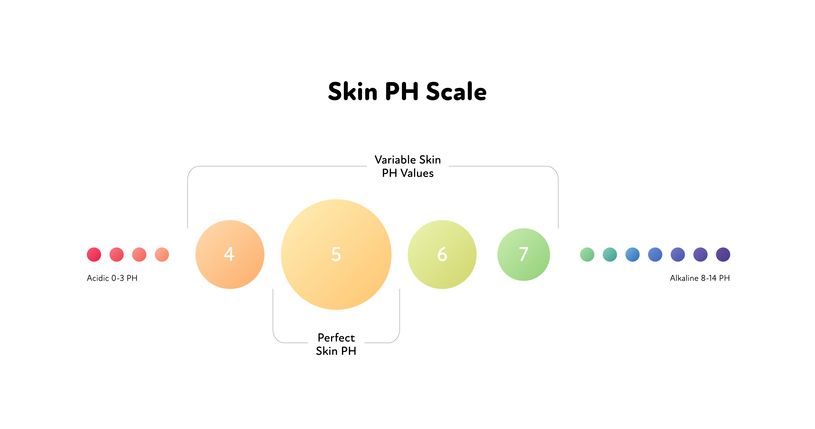
1. Skin pH Plays a Central Role in Skin Health
Most people focus on skincare products and ingredients, but fewer pay attention to the pH levels of those products — or their own skin. The skin's natural pH typically stays between 4.5 and 5.5. This slightly acidic range helps maintain the skin barrier, keeps the acid mantle intact, and supports healthy sebum production.
A balanced skin pH defends against harmful bacteria, prevents dryness, and allows the skin to retain moisture. Without this balance, even a good skincare routine can stop working properly.
2. Disruption Comes from External and Internal Factors
The pH of your skin can shift due to both external and internal factors. Harsh ingredients, alkaline cleansers, over exfoliating, and sun exposure all raise the skin’s pH level. Internally, stress, diet, and hormone changes can also interfere with pH balance.
Even something as simple as using the wrong cleanser or washing your face with hot water can disturb the skin’s surface pH. That’s why consistent habits matter just as much as the products you use.
3. Your Skin Gives You Signals
When your skin pH is out of balance, you’ll often notice signs like tightness, dryness, or increased breakouts. These aren’t just surface-level issues — they’re signals that the skin barrier is no longer functioning the way it should.
Instead of adding more products, the better approach is to look at what might be disrupting your pH levels and focus on restoring your skin’s natural balance.
Book Now to Experience
Acne Treatment
1 Minute Self-Registration
Date should not be before minimal date

Disrupted pH Effects
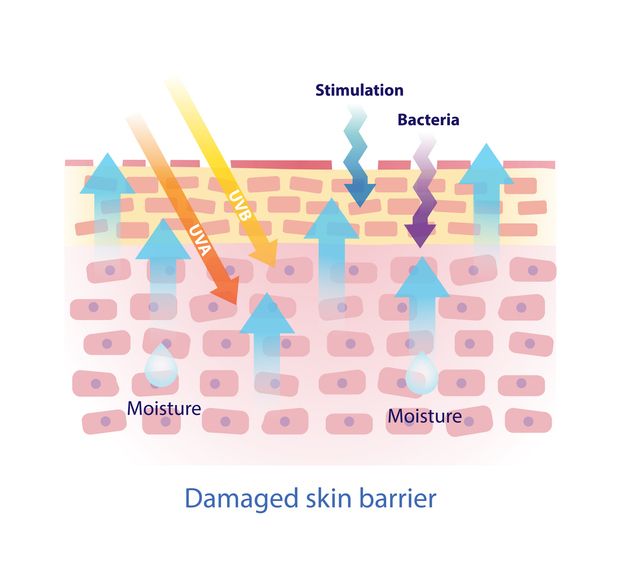
1. A Weakened Skin Barrier
When your skin’s pH shifts too far from its natural range, the skin barrier starts to break down. This layer normally locks in moisture and keeps out bacteria and irritants. Once weakened, the skin becomes more vulnerable to dryness, redness, and environmental aggressors.
2. Increased Sensitivity and Irritation
A disrupted pH level makes the skin more reactive. You might feel burning or stinging when applying products that never used to cause a problem. This sensitivity happens because the skin’s barrier can no longer block out harsh ingredients or keep hydration in.
3. Imbalance in Oil Production
When the pH of your skin is off, sebum production becomes unstable. Some areas may overproduce oil, leading to clogged pores and acne. Other areas might dry out, flake, or feel rough. This imbalance can cause combination skin or worsen existing skin conditions.
4. Dehydration and Early Signs of Aging
A high or low pH can affect how well your skin holds moisture. Without proper hydration, your skin may develop fine lines faster or feel tight and dull. This is often mistaken for aging but is actually a sign of disrupted moisture balance caused by pH problems.
5. Disrupted Skin Microbiome
Your skin has a natural layer of bacteria that protects against infection and supports healthy cell turnover. When the pH shifts, this microbiome becomes unstable. This can lead to ongoing inflammation, breakouts, or slow healing of damaged skin.

Daily Habits That Disrupt Your Skin’s pH Level

1. Using Harsh Cleansers
Cleansers with a high pH or strong surfactants like sodium lauryl sulfate can strip away the skin’s natural oils. This damages the acid mantle and weakens the skin barrier. Without that protection, your skin can become dry, irritated, or more prone to breakouts.
2. Washing with Hot Water
Hot water may feel good, but it disrupts your skin’s natural pH and removes essential moisture. Over time, this weakens the skin surface and can lead to tightness, flaking, or increased oil production as your skin tries to balance itself.
3. Over-Exfoliating
Exfoliating too often, or using strong physical scrubs and chemical acids, breaks down the skin barrier. This makes the pH level harder to control and increases sensitivity. If your skin feels raw or looks red after exfoliating, it may be a sign of pH disruption.
4. Overloading Active Ingredients
Using too many actives like retinoids, alpha hydroxy acids, or vitamin C at once can overwhelm your skin’s ability to stay balanced. These ingredients are effective but need to be used with care. Overuse can shift your skin’s pH too far from its natural zone.
5. Exposure to Environmental Stress
Sun exposure, air pollution, and hard tap water can all raise the skin’s pH. These external factors wear down your skin’s natural defenses over time. If your skin feels more reactive after being outside or looks dull despite a good routine, environmental stress may be disrupting your pH balance.
6. Using Incompatible Product Combinations
Layering products without checking their compatibility can create an unstable surface pH. If your routine includes multiple active ingredients, switching between acidic and alkaline formulas may lead to irritation and weakened skin barrier function.
Book Now to Experience
Acne Treatment
1 Minute Self-Registration
Date should not be before minimal date

How to Test and Monitor Your Skin’s pH Balance

1. Use pH Testing Strips
pH test strips are a quick and easy way to check your skin’s pH at home. Press the strip gently against clean, dry skin — usually on the forehead or cheek — and compare the color change to the scale provided. The ideal reading should be between 4.5 and 5.5.
2. Try a Skin pH Meter
Some skin analysis devices can measure your skin surface pH more accurately than strips. These are more commonly used in professional settings but are available for home use. They provide digital results and help you track subtle changes over time.
3. Apply Litmus Paper After Cleansing
Litmus paper is another option, though slightly less accurate. After washing your face and letting it dry, gently press the paper to different areas of your skin. It gives a basic reading of whether your skin leans more acidic or alkaline.
4. Watch for Physical Symptoms
Even without tools, you can observe how your skin responds. If you notice frequent irritation, flaky skin, or breakouts in new areas, your skin’s pH may be unbalanced. A sudden change in how your skin reacts to products is also a sign to check your pH levels.
5. Track Your Routine and Reactions
Keep a journal of your skincare routine, products used, and any changes in your skin. Note when symptoms like dryness or excess oil begin. If you make changes to your skincare products, record how your skin reacts — this can help you connect symptoms with shifts in pH.

Understanding pH Test Results
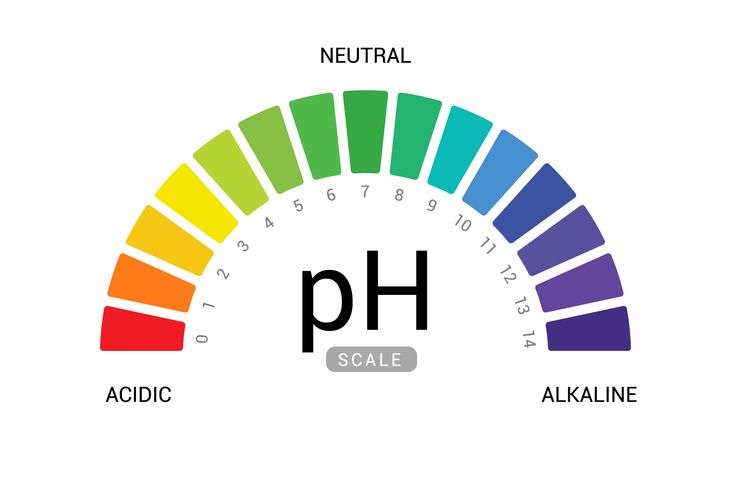
1. What the Numbers Mean
The pH scale ranges from 0 to 14. Skin that falls between 4.5 and 5.5 is considered healthy and slightly acidic. This level supports the skin barrier, maintains hydration, and protects against bacteria. If your results are outside this range, your skin may be more prone to irritation or skin conditions.
2. High pH Indicates Alkaline Skin
If your pH reading is above 5.5, your skin is too alkaline. This can cause dryness, flaking, and sensitivity. Alkaline skin often feels tight after washing and may become red or inflamed. It also struggles to retain moisture, leading to an uneven texture and fine lines.
3. Low pH Indicates High Acidity
If your test result is below 4.5, your skin is too acidic. This can lead to irritation, burning sensations, and an increase in breakouts. A very low pH may also damage your skin barrier, especially if you’re using multiple acids or strong exfoliants.
4. Track Changes Over Time
Testing once won’t tell you everything. Your skin’s pH can change based on your routine, diet, stress, and environment. Monitoring results over time helps you spot patterns — for example, if a new product is pushing your skin out of its natural range.
5. Adjust Your Routine Based on the Results
If your skin’s pH is too high or too low, start by removing possible irritants like harsh cleansers or overused actives. Focus on gentle, pH balanced products and give your skin time to recover. If the imbalance continues or worsens, consider seeing a dermatologist.
Book Now to Experience
Acne Treatment
1 Minute Self-Registration
Date should not be before minimal date

Natural Ways to Restore Your Skin’s pH Equilibrium

1. Apply Raw Honey Masks
Raw honey has a natural pH close to that of healthy skin. It contains antibacterial and soothing properties that support your skin barrier. Apply a thin layer to clean skin and leave it on for about 15 minutes before rinsing with lukewarm water. This helps calm irritation and gently exfoliate dead skin cells.
2. Use Diluted Apple Cider Vinegar
Apple cider vinegar has a low pH and can help balance skin that’s too alkaline. Mix one part vinegar with four parts filtered water and apply it as a toner using a cotton pad. This solution can help restore your skin’s natural pH and reduce surface bacteria, but should not be used on broken or very sensitive skin.
3. Try a Yogurt and Cucumber Mask
Greek yogurt contains lactic acid, a gentle exfoliant that helps maintain a healthy skin pH. Cucumber soothes inflammation and hydrates dry areas. Blend the two into a smooth paste and apply for 10 to 15 minutes to refresh your skin and promote a balanced surface pH.
4. Rinse with Green Tea
Green tea is rich in antioxidants that reduce inflammation and support skin barrier function. Let the tea cool and use it as a gentle rinse or toner. It helps regulate oil production and supports a calm, healthy skin environment.
5. Use Fresh Aloe Vera Gel
Aloe vera gel taken directly from the plant has pH-balancing properties and helps repair damaged skin. It hydrates without clogging pores and supports the skin’s natural healing process. Apply a thin layer to clean skin and leave it on until fully absorbed.

Professional Acne Treatment to Support pH Balance and Skin Health
1. Why Acne-Prone Skin Often Struggles With pH Imbalance
People with acne-prone or sensitive skin often have a disrupted skin pH. When the pH of your skin shifts too far from the slightly acidic range (4.5 to 5.5), the skin barrier becomes compromised. This leads to excessive oil production, inflammation, clogged pores, and breakouts.
Even if you're using pH balanced cleanser and adjusting your skincare routine, deeper congestion and long-term oil imbalance can be harder to fix at home.
2. How Acne Treatment Helps Restore Balance
New Beauty’s Acne Treatment is a non-invasive solution designed to support balanced skin pH and improve overall skin health. The treatment works in three steps:
• Dual spiral suction with drainage technology removes excess oil, dead skin cells, and impurities from clogged pores. This clears buildup that contributes to an imbalanced skin surface and helps calm existing acne.
• Vacuum exfoliation supports your skin’s natural turnover without over-exfoliating, which protects the skin barrier and avoids disrupting the acid mantle.
• A hydrating serum is infused directly into the skin to soothe inflammation, regulate sebum production, and help the skin retain moisture. This rebalances the water-oil ratio, which supports a healthier, more stable skin pH.
3. Benefits Beyond Clearer Skin
This treatment does more than reduce blemishes. It supports the skin’s barrier function, balances oil levels, and improves how the skin handles environmental factors. By helping restore the skin’s natural pH and reducing external triggers of irritation, the treatment can reduce both acne breakouts and sensitivity over time.
• Non-invasive and needle-free
• Targets whiteheads, blackheads, acne scars, and oily skin
• Helps maintain a slightly acidic, healthy skin surface
• Suitable for moderate to severe acne-prone skin
• No downtime required
4. Supports Long-Term Skin Health
Balancing the skin pH isn’t just about applying the right products — it also means addressing blocked pores, inflammation, and weakened skin barrier function from below the surface. Acne Treatment works with your skin’s natural pH instead of disrupting it, making it ideal for maintaining balanced skin over time.
Ready to get your skin’s pH levels back on track and restore calm, healthy skin?
Book your free Acne Treatment trial today and experience clearer, more balanced skin — from the inside out.
New Beauty's Acne TreatmentBook Now to Experience
Acne Treatment
1 Minute Self-Registration
Date should not be before minimal date
FAQ
Can Hormonal Changes Affect My Skin's Ph Balance During Pregnancy?
Your hormonal changes during pregnancy can absolutely impact your skin's pH balance. Your body's fluctuating estrogen and progesterone levels can throw your skin's natural acid mantle out of whack, affecting its pH levels. You'll notice these changes most during your first and third trimesters when hormonal shifts are at their peak. Trust your body's wisdom while practicing gentle skincare routines.
How Long Does It Typically Take to Restore Normal Skin Ph?
Your skin's pH balance can typically be restored within 2-4 weeks when you're following a consistent skincare routine. You'll need to stick with pH-balanced products and avoid harsh cleansers that disrupt your skin's natural acid mantle. If you've been using gentle, pH-appropriate products, you might see improvements in as little as 5-7 days.
Are There Specific Ph Levels That Work Better for Different Ethnicities?
While skin pH typically ranges from 4.5 to 6.5 across all ethnicities, research hasn't shown that specific pH levels work better for different racial groups. What's most important is understanding your individual skin's needs - darker skin tends to be more sensitive to pH disruption, while East Asian skin often responds better to slightly acidic products.
Can Medications Alter My Skin's Natural Ph Balance?
Yes, your medications can substantially impact your skin's natural pH balance. Both topical and oral medications can disrupt your skin's acid mantle. Antibiotics, acne treatments like benzoyl peroxide, and certain antidepressants are common culprits. You'll want to check with your healthcare provider about potential skin effects and consider adjusting your skincare routine to maintain balance while taking medications that might affect your skin's pH.
Does Living in Different Climates Affect Optimal Skin Ph Levels?
Your skin's pH needs shift with climate changes. When you move between humid and dry environments, your skin works overtime to maintain its ideal pH balance. You'll notice your skin becomes more acidic in humid climates to fight bacteria growth, while in dry climates, it may become more alkaline as it struggles to retain moisture. Understanding these shifts empowers you to adjust your skincare accordingly.
Recommended Articles
COPYRIGHT© NEW BEAUTY MANAGEMENT LIMITED 2025. ALL RIGHT RESERVED.

